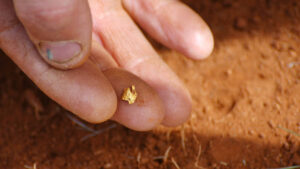ASX small cap gold stocks are up 20 per cent in 6 months — will the run continue?

Pic: Getty
It’s been a magical few months for gold stocks on the ASX. While some have seen more exploration success than others there’s no doubt what the catalyst was for the entire sector’s performance.
The spot gold price hit A$2000 on June 21 and has continued to rise. As at 12.30pm yesterday it was $2171.
As a result, the 134 ASX small cap gold stocks have gained an average 20 per cent in six months. While not all stocks have enjoyed the gains of the commodity price, the majority of companies have.

But will it continue?
Analysts think gold will continue to rise into 2020. There are two reasons why.
First, its perception as a safe haven in the context of an uncertain economic outlook and low interest rates.
Last month at the Exchange SA conference Magellan Asset Management’s Emma Kirk said she believed low interest rates would persist for some time.
While she did not specifically mention gold, she said investing in mega-trends that will happen regardless of the economy was the best bet to create value
Furthermore, the geopolitical and trade tensions are unlikely to disappear any time soon and while much of the once immortal tech sector has suffered, gold has not.
Second is demand for gold in consumer market — particularly jewellery which accounts for 52 per cent of gold demand. Physical gold holding is the next largest source of demand accounting for one third.
Bloomberg analyst Eily Ong said earlier this week, “We see official gold holdings rising this year, particularly in emerging markets, as appetite will likely keep recovering.
“The industrial-gold-applications buying trend should also be sustained through 2020, as consumption in electronics and decorative use improves, particularly if there’s any metal-price weakness on dollar appreciation.”
But don’t forget project fundamentals
Ultimately the gold has to come from somewhere, and just because gold is in the ground, it doesn’t mean it can be recovered.
S&P analyst Jarrett Bilous said unfriendly governments could be a threat. While everyone associates Tanzania’s regulatory issues with the graphite sector, the catalyst was gold miner Barrick.
“Jurisdictional risk remains an overhang for some gold producers, namely from unstable operating conditions (such as taxation and permitting) or social considerations, and could intensify with new development projects,” he said.
And of course, there is a difference between investing in a company and the physical currency.
One way to do the latter is the ETFs Physical Gold ETF (ASX:GOLD) which has surged this year in conjunction with the price rise. It’s up 18 per cent in 2019.
“We’re in no rush to raise ratings”
Bilous’ comments were made in a report on credit ratings for large miners which stated even though prices were high, it was in no rush to raise ratings.
“Prices have historically fluctuated, and we incorporate the potential for volatility into our ratings,” he said.
“There are also several other factors to consider beyond stronger estimated credit measures linked to higher prices, which could very well prove to be temporary.
“In particular, the industry is capital-intensive and must contend with ongoing cost inflation, which has contributed to low returns on capital for many issuers.
“Non-investment-grade gold producers could become candidates for an upgrade if higher prices translate into stronger cash flow available to complete projects that positively affect the value of output. We view this as unlikely within the next 12 months.
“We don’t expect to raise our ratings on most of our investment-grade gold universe, at least not for the next few years, in the absence of sustainably stronger returns on capital.”
READ MORE:
Here’s why the founder of the world’s largest hedge fund tips more growth for gold
UNLOCK INSIGHTS
Discover the untold stories of emerging ASX stocks.
Daily news and expert analysis, it's free to subscribe.
By proceeding, you confirm you understand that we handle personal information in accordance with our Privacy Policy.








